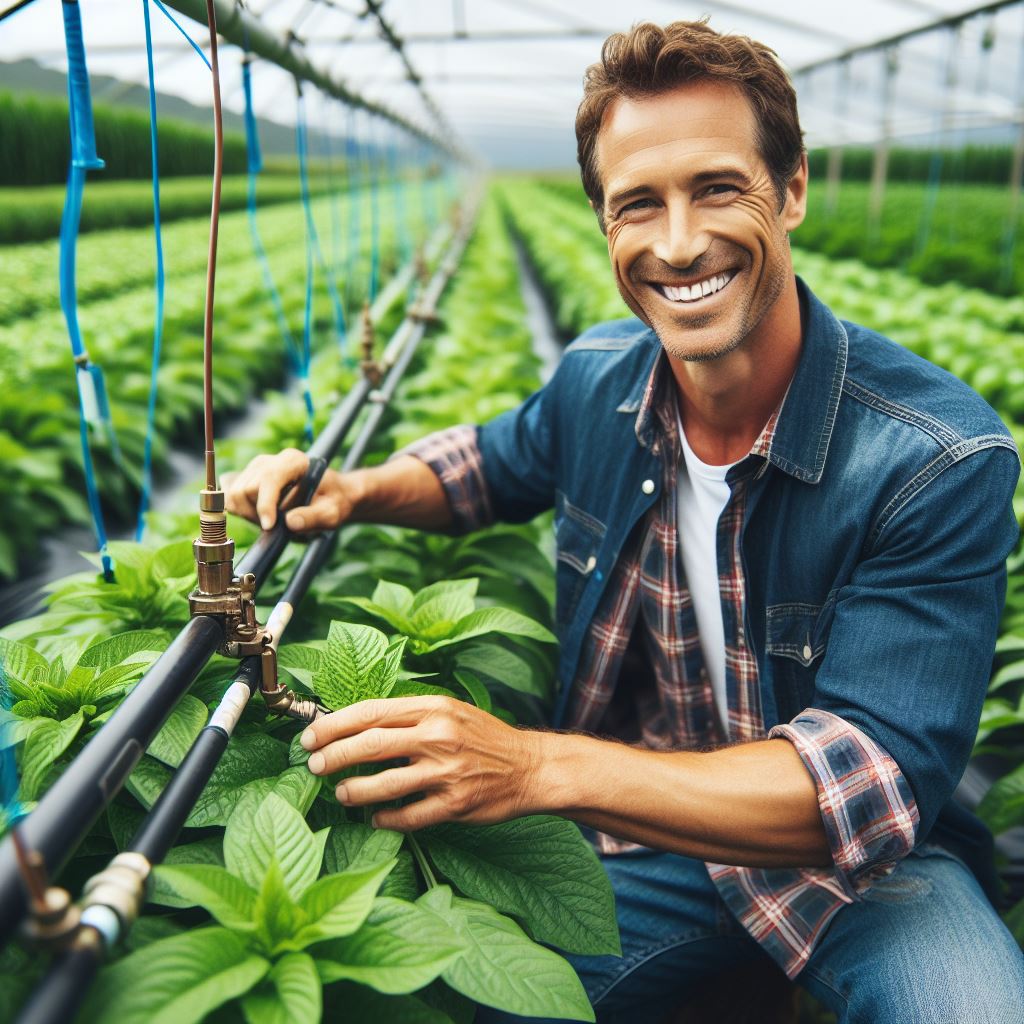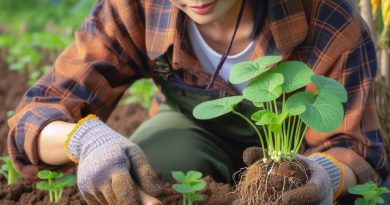Drip Irrigation: Small Farm Water-Saving Guide
Last Updated on February 6, 2024
Introduction
Importance of water conservation in agriculture
The implementation of the ‘Drip Irrigation Small Farm Water Saving Guide’ is crucial in addressing the pressing issue of water scarcity in agriculture, emphasizing the significance of water conservation for the promotion of sustainable farming practices.
Drip irrigation is an innovative and efficient technique that conserves water by delivering it directly to the roots of plants.
In this blog post, we will explore the benefits and implementation of drip irrigation, particularly aimed at assisting small farmers.
Introducing drip irrigation as a water-saving technique
Drip irrigation is a water-saving solution that minimizes wastage by directing water where it is needed the most.
By avoiding water runoff and evaporation, this technique maximizes water efficiency.
Small farmers can greatly benefit from drip irrigation as it helps them optimize their water usage and enhance crop yield.
Purpose of the blog post
This blog post will provide a step-by-step guide on installing a drip irrigation system, selecting appropriate equipment, and understanding the necessary maintenance.
We will also discuss the advantages of drip irrigation, such as reduced weed growth, fertilizer efficiency, and uniform water distribution.
Additionally, we will address common challenges faced by small farmers when implementing drip irrigation, including initial costs and system design.
Practical tips and cost-effective solutions will be shared to assist farmers in overcoming these barriers.
By the end of this blog post, small farmers will have a comprehensive understanding of drip irrigation and how it can be utilized to save water, increase crop productivity, and ultimately contribute to sustainable agriculture.
Let’s dive into the world of drip irrigation and empower small farmers to make a positive impact on water conservation.
Understanding Drip Irrigation
Definition and basic concept of drip irrigation
Drip irrigation is a water-saving irrigation method that delivers water directly to plant roots.
It involves the slow and precise application of water through a network of tubes or pipes.
This method ensures that only the required amount of water reaches the plants, minimizing evaporation and runoff.
Components of a drip irrigation system
- Drip tape or tubing: Drip tape is a thin plastic tube with tiny holes that releases water into the soil near plant roots. It can be laid on the surface or buried underground, depending on the crop’s requirements.
- Emitters or drippers: Emitters are devices attached to the drip tape that regulate the flow of water. They ensure an even distribution of water to each plant, optimizing water usage and preventing waterlogging.
- Water source and filtration: A drip irrigation system requires a water source, such as a well or reservoir, to supply water to the plants. To prevent clogging of emitters, filters should be installed to remove debris and sediment from the water.
- Pressure regulators and valves: Pressure regulators reduce the incoming water pressure to a level suitable for efficient drip irrigation. Valves control the flow of water within the system, allowing users to adjust water distribution based on plant needs.
- Optional features (timer, fertilizer injector, etc.): A timer can be added to automate irrigation schedules, ensuring plants receive water at optimal times. A fertilizer injector can also be integrated into the system, providing plants with nutrients directly through the irrigation water. Optional features enhance the efficiency of a drip irrigation system and improve plant growth.
By understanding the components of a drip irrigation system, farmers can make informed decisions regarding its installation and operation.
Drip irrigation offers numerous benefits, including water conservation, optimized plant growth, reduced weed growth, and lower labor requirements.
It is suitable for small farms and gardens, as well as commercial agricultural operations.
In the next section, we will explore the advantages and disadvantages of drip irrigation in more detail.
Read: Eco-Friendly Farming: Water Conservation Tricks
Advantages of Drip Irrigation for Small Farms
Increased water efficiency and reduced water waste
Drip irrigation offers numerous benefits that make it an ideal system for small farms looking to conserve water and improve crop yields.
First and foremost, drip irrigation delivers water directly to plant roots via drip emitters, reducing water waste from evaporation or runoff.
This targeted watering results in water savings of up to 70% compared to conventional irrigation methods.
Improved plant health and reduced weed growth
The slow and steady delivery of water also encourages healthier root systems and plant growth.
Weed growth is minimized since only the soil immediately around the plant is dampened.
Minimized labor and reduced physical effort for farmers
In addition to water savings, drip irrigation requires less labor than hand watering or moving sprinklers.
Once the system is set up, it can water the crops unattended.
The reduced need for physical effort makes drip a practical option for small farms with limited labor capacity.
Drip tubing is flexible and can snake throughout a field or greenhouse to deliver water precisely where it’s needed.
This adaptability means drip can be used for a wide variety of crops and soil types.
Scalability and cost-effectiveness for small farms
Lastly, drip kits are affordable and scalable.
Farmers can start with a small system and expand it as their operation grows.
While the initial investment may be higher than a sprinkler system, the long-term water and labor savings make drip irrigation a cost-effective choice for small farms looking to maximize limited resources.
In general, drip irrigation offers numerous advantages for small farms, including increased water efficiency, improved plant health, minimized labor, compatibility with various soil types and crops, as well as scalability and cost-effectiveness.
Small farmers can benefit greatly from adopting this advanced irrigation method, enhancing their productivity and sustainability.
Read: Maximize Yields, Minimize Water in Urban Farms
Planning and Designing a Drip Irrigation System
Assessing water requirements and designing zones
- Determine the water needs of your crops by considering their specific requirements for optimal growth.
- Analyze factors such as soil type, climate, and plant size to accurately assess water requirements.
- Divide your farm into zones based on crop water needs to ensure efficient water distribution.
- Group plants with similar water requirements together in each zone to avoid overwatering or underwatering.
Determining water sources and availability
- Identify the available water sources on your farm, such as wells, rivers, or reservoirs.
- Consider the reliability and stability of each water source to ensure constant water supply.
- Calculate the water availability and estimate the total water required for your drip irrigation system.
- Determine if additional water storage or treatment is necessary to meet your farm’s water demands.
Calculating system capacity and flow rates
- Determine the water capacity needed for your drip irrigation system based on the total water requirements.
- Calculate the flow rate required for each zone to ensure proper water distribution.
- Consider the pressure requirements of different emitter types to optimize system performance.
- Ensure that your water source can supply the necessary flow rate to avoid system inefficiencies.
Layout and spacing considerations for drip lines
- Plan the layout of your drip lines to minimize water waste and provide even coverage to your crops.
- Consider the topography and terrain of your farm when determining the layout and elevation of your drip lines.
- Opt for a grid pattern for flat terrains and a contour pattern for sloping areas to ensure uniform water distribution.
- Determine the spacing between drip lines based on crop requirements and soil characteristics to avoid over or under irrigating.
Choosing the right emitters and components
- Select emitters that are suitable for your crop’s water requirements and soil conditions.
- Consider factors such as flow rate, watering pattern, and filtration needs when choosing emitters.
- Use pressure regulators and filters to maintain optimal performance and prevent clogging.
- Ensure that all components, including connectors and fittings, are compatible with your chosen emitters and drip lines.
In essence, careful planning and designing are crucial in developing an efficient drip irrigation system for small farms.
By assessing water requirements, designing zones, determining water sources and availability, calculating system capacity and flow rates, and considering layout and spacing, farmers can optimize water usage and ensure proper water distribution.
Additionally, choosing the right emitters and components is vital to achieve the desired irrigation outcomes.
Taking these steps will not only save water but also contribute to the overall success and sustainability of small-scale farming operations.
Read: Water-Wise Gardening: Simple Steps for Hobbyists
Installing a Drip Irrigation System
Site preparation and soil analysis
Before installing a drip irrigation system, it is important to prepare the site and analyze the soil.
- Clear the area of any debris or obstacles that may interfere with the system.
- Conduct a soil analysis to determine its moisture-holding capacity and nutrient levels.
- Make sure the soil is well-drained to avoid waterlogging issues.
Digging trenches or burying drip lines
Once the site is prepared, the next step is to dig trenches or bury the drip lines.
- Start by marking the layout of where the drip lines will be placed.
- Use a shovel or a trenching machine to dig trenches along the marked lines.
- The depth of the trenches should be based on the recommended depth for the specific drip system being used.
- Alternatively, if burying drip lines, ensure they are installed at the appropriate depth, usually around 6 inches.
Proper emitter placement and spacing
The correct placement and spacing of emitters are crucial for efficient water distribution.
- Attach the emitters to the drip lines at the desired locations for watering each plant.
- Consider the water requirements of different plants and adjust the placement and spacing accordingly.
- Ensure the emitters are placed close to the root zone of each plant to maximize water absorption.
Connecting components and ensuring proper fittings
To ensure the drip irrigation system functions properly, it is important to connect the components correctly.
- Connect the mainline to the water source using a backflow preventer and a pressure regulator.
- Attach the drip lines or laterals to the mainline with appropriate connectors or fittings.
- Check for any leaks or loose connections and fix them before proceeding.
Testing and adjusting the system for uniform water distribution
After the installation is complete, it is essential to test and adjust the system for uniform water distribution.
- Turn on the water supply and observe the flow rate and distribution of water from the emitters.
- Inspect each emitter for clogging or uneven water discharge and make adjustments as needed.
- Check the water pressure to ensure it is within the recommended range for efficient operation.
- Monitor the system over time and make necessary changes to ensure uniform water distribution.
By following these steps, you can successfully install a drip irrigation system for your small farm, saving water and promoting efficient plant growth.
Read: Smart Watering: Techniques for Small-Scale Farms

Operating and Maintaining a Drip Irrigation System
Monitoring soil moisture levels and adjusting irrigation frequency
- Regularly check the moisture level of the soil by using a soil moisture meter.
- Adjust the irrigation frequency based on the needs of the plants and the soil moisture levels.
- Monitor the weather conditions and make necessary changes to the irrigation schedule.
- Avoid overwatering by ensuring that the soil is adequately moist but not saturated.
Managing system pressure and avoiding clogs
- Regularly check the system pressure using a pressure gauge to ensure it is within the recommended range.
- Install pressure regulators to maintain a consistent and optimum pressure in the system.
- Clean filters regularly to prevent clogs and ensure the smooth flow of water through the drip lines.
- Use drip tape or emitters with anti-clogging features to minimize the risk of clogs.
Conserving water through scheduling and mulching
- Create an irrigation schedule based on the water requirements of the plants and the soil type.
- Water during cooler times of the day to minimize evaporation and water loss.
- Apply mulch around plants to reduce water evaporation and maintain soil moisture.
- Consider using a rain sensor or moisture sensor to prevent irrigation when it is not necessary.
Inspecting and repairing damaged components
- Regularly inspect the drip lines, emitters, and connectors for any leaks, cracks, or blockages.
- Replace or repair damaged components immediately to prevent water wastage and ensure efficient operation.
- Check the tubing for any signs of wear and tear and replace them if necessary.
- Regularly inspect and maintain the valves and backflow preventers to avoid system malfunctions.
Winterizing the system and preparing for off-season storage
- Before freezing temperatures arrive, drain the system of all water to prevent damage from ice formation.
- Remove all drip lines, emitters, and fittings and store them in a dry and protected area.
- Clean and dry all components before storing them to prevent the growth of mold or bacteria.
- Insulate exposed pipes and valves to protect them from freezing temperatures during the winter.
Operating and maintaining a drip irrigation system is essential for its effective and efficient operation.
By monitoring soil moisture levels, managing system pressure, conserving water through scheduling and mulching, inspecting and repairing damaged components, and winterizing the system, farmers can ensure optimal water usage and a healthy crop yield.
Tips for Maximizing Water Savings with Drip Irrigation
Implementing water-saving techniques like rainwater harvesting
- Install rain barrels or tanks to collect rainwater for irrigation purposes.
- Redirect gutter downspouts to channel rainwater into storage containers.
- Use a filtration system to remove debris and contaminants from harvested rainwater.
- Integrate a drip irrigation system that can efficiently utilize collected rainwater for crop irrigation.
Using sensors and smart technology for automated irrigation
- Install soil moisture sensors to measure the water content in the soil and adjust irrigation accordingly.
- Utilize weather-based controllers that automatically adjust irrigation schedules based on local weather conditions.
- Integrate flow sensors to detect leaks or malfunctions in the irrigation system and prompt timely repairs.
- Invest in smart irrigation systems that can be controlled remotely through mobile applications or computer interfaces.
Proper crop selection and grouping for efficient water usage
- Choose drought-tolerant crop varieties that require less water for growth and development.
- Group crops with similar water requirements together to avoid over-watering or under-watering.
- Rotate crops to prevent the accumulation of pests and diseases, reducing the need for excessive watering.
- Implement cover crops or mulching to reduce evaporation, maintain soil moisture, and suppress weed growth.
Regular system maintenance and performance evaluation
- Perform routine checks to ensure there are no clogs, leaks, or damaged emitters in the drip irrigation system.
- Clean filters regularly to prevent blockages and maintain optimal water flow.
- Check valve functioning to ensure proper water distribution and prevent water wastage.
- Evaluate system performance by monitoring water usage, crop health, and overall irrigation efficiency.
Educating farmers and workers on water conservation practices:
- Organize workshops or training sessions to raise awareness about the importance of water conservation.
- Teach farmers and workers about proper irrigation techniques, such as scheduling, timing, and duration.
- Encourage the adoption of water-saving practices, such as the use of drip irrigation and smart technologies.
- Promote the benefits of water conservation, such as reduced costs, increased crop yields, and environmental sustainability.
By implementing these tips, farmers can maximize water savings, minimize water wastage, and promote sustainable agriculture through efficient drip irrigation.
Conclusion
In this blog post, we discussed the key points regarding drip irrigation and its importance in saving water on small farms.
To recap, drip irrigation is a highly efficient method that delivers water directly to the roots of plants, reducing water waste and maximizing crop yield.
It helps conserve water resources and minimizes the negative environmental impact of conventional irrigation methods.
Small farmers are encouraged to implement drip irrigation systems on their farms.
By doing so, they can significantly improve water management, reduce water expenses, and enhance crop productivity.
In a nutshell, water-saving techniques like drip irrigation play a crucial role in sustainable agriculture.
The responsible use of water resources is essential to ensure our ability to feed a growing population and protect the environment for future generations.


